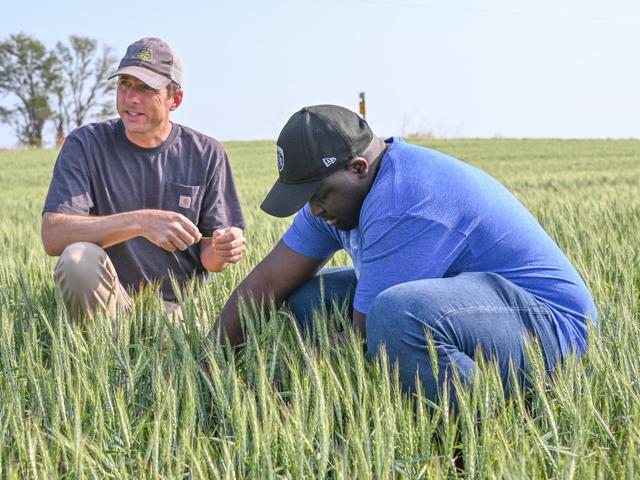HWW Tour Estimates 39.5 BPA on Day 1
Drought and Heat Stress Take Toll on Hard Winter Wheat
COLBY, Kan. (DTN) -- The Wheat Quality Council's annual Hard Winter Wheat tour Day 1 estimated yield results of 39.5 bushels per acre (bpa) on Tuesday, May 17, are in line with USDA projections for Kansas.
The tour made 248 stops through central and northern Kansas, and a few of the southernmost counties in Nebraska, to measure wheat production and health. Drought and heat stress has taken a toll on the crop -- gaping cracks in some fields more than a foot deep were found due to poor moisture levels -- but disease and pest pressure was light.
"The crop is about what we expected," said Romulo Lollato, Kansas State University Extension wheat specialist. "Wheat is better in the eastern part of the state (Kansas), which is still dry, with some fields going 45 to 65 bpa. Then there's rough wheat to the west, especially in the double-crop fields, where we saw 10 to 15 bpa."
He added that wheat on fallow ground looked better than wheat after corn and soybeans. "We saw wheat today (May 17) that looked better than other fields, but comparing to last year, the yield potential is not nearly as good."
Last year's Day 1 yield estimate was 59.2 bpa, possibly the highest for a first day in the tour's 40-plus-year history. Some first-day yield estimates topped 80 bpa.
Growing conditions in 2021 were nearly ideal. Kansas, the top wheat-growing state, produced 364 million bushels last year, averaging 52 bpa.
P[L1] D[0x0] M[300x250] OOP[F] ADUNIT[] T[]
One of Justin Knopf's wheat fields near Gypsum, Kansas, assessed on the tour would normally yield about 65 bpa with adequate moisture. But it only received 2.5 inches of rain from Nov. 1 through May 1, which isn't near enough for normal plant development. Since May 1, another 1.5 inches of rain fell, but he's afraid it's too little too late.
"The field will probably yield in the mid-40s (bushels per acre)," Knopf said. He stopped by the field to chat with tour participants. "Our overall yields will be below our average of 50 bpa. I think our whole farm average will be in the upper 30s."
He planted 1,600 acres of hard red winter wheat this year. The near certainty of producing less wheat than normal this year when the world needs it more than ever weighs heavily on Knopf's mind.
-- Ukraine's wheat production and exports will be limited due to Russia's attack on the country.
-- India recently announced it will stop wheat exports.
-- USDA estimated ending wheat stocks for the world's top eight exporters, including the United States, will total 1.78 billion bushels in 2022-23, the lowest exportable supplies in 15 years.
"It's unfortunate we didn't get enough rain with what's happening in the world," Knopf said. "Wheat is an important crop to feed people. I feel the responsibility of being a supplier of food. I take the responsibility to do what I can to preserve the yield I do have seriously."
He did spray the field recently for brown wheat mites.
Spotty stand establishment was a common site on Day 1 of the tour, and that will likely continue to be a trend, wheat specialists said.
On Wednesday, May 18, tour scouts will travel through western, southwestern and south-central Kansas. One route will dip into northern Oklahoma. The day will end in Wichita.
"In southwest Kansas, because of the poor conditions, people will try to figure out how many fields will be abandoned," said Kansas Wheat CEO Justin Gilpin. "As we move closer to Wichita, we will (likely) see higher yields."
Watch a video interview with Gilpin about Day 1 of the wheat tour here: https://www.dtnpf.com/….
Matthew Wilde can be reached at matt.wilde@dtn.com
Follow him on Twitter @progressivwilde
(c) Copyright 2022 DTN, LLC. All rights reserved.






